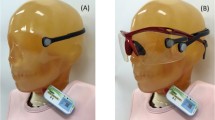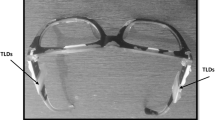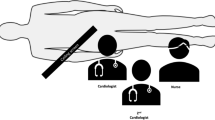Abstract
Occupational eye dose monitoring during interventional radiology and interventional cardiology is important to avoid radiation-induced cataracts. The aim of this study was to assess the eye dose correlation with neck dose and patient-related quantities for interventional cardiology physicians and nurses. The originality of this study lies in obtaining correlations between the location of the dosimeter and eye dose radiation readings among different procedures and practitioners. The doses were measured for each procedure (18 procedures of coronary angiography and 16 procedures of percutaneous coronary intervention) using an active personal dosimeter. The eye dose for physicians was not correlated with the neck dose. The eye dose for nurses had a good correlation with the neck dose during both coronary angiography (R2 = 0.91) and percutaneous coronary intervention (R2 = 0.93). Kerma-area product values may be used for a rough estimation of the eye dose for physicians during routine coronary angiography procedures (R2 = 0.76). For nurses, the neck dose is a good proxy for the eye dose during coronary angiography and percutaneous coronary intervention procedures.
















Similar content being viewed by others
References
Balter S, Miller DL. Patient skin reactions from interventional fluoroscopy procedures. Am J Roentgenol. 2014;202:W335-342. https://doi.org/10.2214/AJR.13.12029.
International Commission on Radiological Protection. Avoidance of radiation injuries from medical interventional procedures, ICRP Publication 85. Ann ICRP. 2001. https://doi.org/10.1016/s0146-6453(01)00004-5.
Chida K, Inaba Y, Masuyama H, Yanagawa I, Mori I, Saito H, Maruoka S, Zuguchi M. Evaluating the performance of a MOSFET dosimeter at diagnostic X-ray energies for interventional radiology. Radiol Phys Technol. 2009;2:58–61. https://doi.org/10.1007/s12194-008-0044-z.
Inaba Y, Nakamura M, Chida K, Zuguchi M. Effectiveness of a novel real-time dosimeter in interventional radiology: a comparison of new and old radiation sensors. Radiol Phys Technol. 2018;11(4):445–50. https://doi.org/10.1007/s12194-018-0484-z.
Kato M, Chida K, Nakamura M, et al. New real-time patient radiation dosimeter for use in radiofrequency catheter ablation. J Radiat Res. 2019;60(2):215–20. https://doi.org/10.1093/jrr/rry110.
Inaba Y, Chida K, Murabayashi Y, Endo M, Otomo K, Zuguchi M. An initial investigation of a wireless patient radiation dosimeter for use in interventional radiology. Radiol Phys Technol. 2020;13:321–6. https://doi.org/10.1007/s12194-020-00575-2.
Chida K, Inaba Y, Masuyama H, Yanagawa I, Mori I, Saito H, Maruoka S, Zuguchi M. Comparison of dose at an interventional reference point between the displayed estimated value and measured value. Radiol Phys Technol. 2011;4:189–93. https://doi.org/10.1007/s12194-011-0121-6.
Chida K, Saito H, Otani H, Kohzuki M, Takahashi S, Yamada S, Shirato K, Zuguchi M. Relationship between fluoroscopic time, dose-area product, body weight, and maximum radiation skin dose in cardiac interventional procedures. Am J Roentgenol. 2006;186(3):774–8. https://doi.org/10.2214/ajr.04.1653.
Chida K, Inaba Y, Saito H, Ishibashi T, Takahashi S, Kohzuki M, Zuguchi M. Radiation dose of interventional radiology system using a flat-panel detector. AJR Am J Roentgenol. 2009;193(6):1680–5. https://doi.org/10.2214/ajr.09.2747.
Chida K, Ohno T, Kakizaki S, Takegawa M, Yuuki H, Nakada M, Takahashi S, Zuguchi M. Radiation dose to the pediatric cardiac catheterization and intervention patient. AJR Am J Roentgenol. 2010;195(5):1175–9. https://doi.org/10.2214/ajr.10.4466.
Kato M, Chida K, Munehisa M, Sato T, Inaba Y, Suzuki M, Zuguchi M. Non-lead protective aprons for the protection of interventional radiology physicians from radiation exposure in clinical settings: An initial study. Diagnostics (Basel). 2021;11(9):1613. https://doi.org/10.3390/diagnostics11091613.
Chida K, Kato M, Kagaya Y, Zuguchi M, Saito H, Ishibashi T, Takahashi S, Yamada S, Takai Y. Radiation dose and radiation protection for patients and physicians during interventional procedure. J Radiat Res. 2010;51(2):97–105. https://doi.org/10.1269/jrr.09112.
Inaba Y, Nakamura M, Zuguchi M, Chida K. Development of novel real-time radiation systems using 4-channel sensors. Sensors (Basel). 2020;20(9):2741. https://doi.org/10.3390/s20092741.
Chida K, Takahashi T, Ito D, et al. Clarifying and visualizing sources of staff-received scattered radiation in interventional procedures. Am J Roentgenol. 2011;197:W900-903. https://doi.org/10.2214/ajr.10.6396.
Kato M, Chida K, Ishida T, et al. Occupational radiation exposure dose of the eye in department of cardiac arrhythmia physician. Radiat Prot Dosim. 2019;187(3):361–8. https://doi.org/10.1093/rpd/ncz175.
Ito H, Kobayashi I, Watanabe K, Ochi S, Yanagawa N. Evaluation of scattered radiation from fluoroscopy using small OSL dosimeters. Radiol Phys Technol. 2019;12(4):393–400. https://doi.org/10.1007/s12194-019-00536-4.
Morishima Y, Chida K, Watanabe H. Estimation of the dose of radiation received by patient and physician during a video fluoroscopic swallowing study. Dysphagia. 2016;31(4):574–8. https://doi.org/10.1007/s00455-016-9718-6.
Haga Y, Chida K, Kimura Y, Yamanda S, et al. Radiation eye dose to medical staff during respiratory endoscopy under X-ray fluoroscopy. J Radiol Res. 2020;61(5):691–6. https://doi.org/10.1093/jrr/rraa034.
Zuguchi M, Chida K, Taura M, Inaba Y, Ebata A, Yamada S. Usefulness of non-lead aprons in radiation protection for physicians performing interventional procedures. Radiat Prot Dosim. 2008;131(4):531–4. https://doi.org/10.1093/rpd/ncn244.
Morishima Y, Chida K, Meguro T. Effectiveness of additional lead shielding to protect staff from scattering radiation during endoscopic retrograde cholangiopancreatography procedures. J Radiat Res. 2018;59(2):225–32. https://doi.org/10.1093/jrr/rrx039.
Chida K, Kaga Y, Haga Y, Kataoka N, Kumasaka E, Meguro T, Zuguchi M. Occupational dose in interventional radiology procedures. AJR Am J Roentgenol. 2013;200(1):138–41. https://doi.org/10.2214/ajr.11.8455.
Chida K, Morishima Y, Inaba Y, Taura M, Ebata A, Takeda K, Shimura H, Zuguchi M. Physician-received scatter radiation with angiography systems used for interventional radiology: comparison among many X-ray systems. Radiat Prot Dosim. 2012;149(4):410–6. https://doi.org/10.1093/rpd/ncr312.
Vano E, Gonzalez L, Beneytez F, Moreno F. Lens injuries induced by occupational exposure in non-optimized interventional radiology laboratories. Br J Radiol. 1998;71:728–33. https://doi.org/10.1259/bjr.71.847.9771383.
Coppeta L, Pietroiusti A, Neri A, Spataro A, De Angelis E, Perrone S, Magrini A. Risk of radiation-induced lens opacities among surgeons and interventional medical staff. Radiol Phys Technol. 2019;12(1):26–9. https://doi.org/10.1007/s12194-018-0487-9.
Ota J, Yokota H, Kawasaki T, Taoka J, Kato H, Chida K, Masuda Y, Uno T. Evaluation of radiation protection methods for assistant staff during CT imaging in high-energy trauma: lens dosimetry with a phantom study. Health Phys. 2021;120(6):635–40. https://doi.org/10.1097/hp.0000000000001391.
International Commission on Radiological Protection. ICRP statement on tissue reactions. 2011. http://www.icrp.org/docs/2011%20Seoul.pdf.
International Commission on Radiological Protection. ICRP Publication 118: ICRP statement on tissue reactions and early and late effects of radiation in normal tissues and organs—threshold doses for tissue reactions in a radiation protection context. Ann ICRP. 2012;41(1/2):1–322. https://doi.org/10.1016/j.icrp.2012.02.001.
Ishii H, Haga Y, Sota M, et al. Performance of the DOSIRIS™ eye lens dosimeter. J Radiol Prot. 2019;39(3):N19-26. https://doi.org/10.1088/1361-6498/ab2729.
Ishii H, Chida K, Satsurai K, et al. A phantom study to determine the optimal placement of eye dosimeters on interventional cardiology staff. Radiat Prot Dosim. 2019;185(4):409–13. https://doi.org/10.1093/rpd/ncz027.
Haga Y, Chida K, Kaga Y, et al. Occupational eye dose in interventional cardiology procedures. Sci Rep. 2017;7(1):569. https://doi.org/10.1038/s41598-017-00556-3.
Kato M, Chida K, Ishida T, et al. Occupational radiation exposure of the eye in neurovascular interventional physician. Radiat Prot Dosim. 2019;185(2):151–6. https://doi.org/10.1093/rpd/ncy285.
Endo M, Haga Y, Sota M, Tanaka A, Otomo K, Murabayashi Y, Abe M, Kaga Y, Inaba Y, Suzuki M, Meguro T, Chida K. Evaluation of novel X-ray protective eyewear in reducing the eye dose to interventional radiology physicians. J Radiat Res. 2021;62(3):414–9. https://doi.org/10.1093/jrr/rrab014.
Inaba Y, Hitachi S, Watanuki M, Chida K. Occupational radiation dose to eye lenses in CT-guided interventions using MDCT-fluoroscopy. Diagnostics (Basel). 2021;11(4):646. https://doi.org/10.3390/diagnostics11040646.
International Commission on Radiological Protection. Occupational radiological protection in interventional procedures. ICRP Publication 139. Ann ICRP. 2018. https://doi.org/10.1177/0146645317750356.
Martin CJ, Magee JS. Assessment of eye and body dose for interventional radiologists, cardiologists, and other interventional staff. J Radiol Prot. 2013;33(2):445–60. https://doi.org/10.1088/0952-4746/33/2/445.
Vanhavere F, Carinou E, Domienik J, et al. Measurements of eye lens doses in interventional radiology and cardiology: Final results of the ORAMED project. Radiat Meas. 2011;46:1243–7. https://doi.org/10.1016/j.radmeas.2011.08.013.
Krim S, Brodecki M, Carinou E, et al. Extremity doses of medical staff involved in interventional radiology and cardiology: correlations and annual doses (hands and legs). Radiat Meas. 2011;46:1223–7. https://doi.org/10.1016/j.radmeas.2011.07.010.
Sanchez RM, Vano E, Fernandez JM, et al. Occupational eye lens doses in interventional cardiology. A multicentric study. J Radiol Prot. 2016;36:133–43. https://doi.org/10.1088/0952-4746/36/1/133.
O’Connor U, Walsh C, Gallagher A, Dowling A, Guiney M, Ryan JM, McEniff N, O’Reilly G. Occupational radiation dose to eyes from interventional radiology procedures in light of the new eye lens dose limit from the International Commission on Radiological Protection. Br J Radiol. 2015;88(1049):20140627. https://doi.org/10.1259/bjr.20140627.
O’Connor U, Gallagher A, Malone L, O’Reilly G. Occupational radiation dose to eyes from endoscopic retrograde cholangiopancreatography procedures in light of the revised eye lens dose limit from the International Commission on Radiological Protection. Br J Radiol. 2013;86(1022):20120289. https://doi.org/10.1259/bjr.20120289.
Gracia-Ochoa M, Candela-Juan C, Vilar-Palop J, Ruiz Rodríguez JC, Soriano Cruz A, Palma Copete JD, Pujades Claumarchirant MC, Llorca DN. Correlation between eye lens doses and over apron doses in interventional procedures. Phys Med. 2020;77:10–7. https://doi.org/10.1016/j.ejmp.2020.07.025.
Inaba Y, Chida K, Kobayashi R, Kaga Y, Zuguchi M. Fundamental study of a real-time occupational dosimetry system for interventional radiology staff. J Radiol Prot. 2014;34:N65-71. https://doi.org/10.1088/0952-4746/34/3/n65.
Božović P, Ciraj-Bjelac O, Petrović JS. Occupational eye lens dose estimated using whole-body dosemeter in interventional cardiology and radiology: a Monte Carlo study. Radiat Prot Dosim. 2019;185(2):135–42. https://doi.org/10.1093/rpd/ncy283.
Vanhavere F, Carinou E, Gualdrini G, et al. ORAMED: optimization of radiation protection of medical staff. EURADOS Report 2012-02. 2012. http://www.eurados.org/~/media/Files/Eurados/documents/EURADOS_Report_201202.pdf.
Principi S, Delgado Soler C, Ginjaume M, Beltran Vilagrasa M, Rovira Escutia JJ, Duch MA. Eye lens dose in interventional cardiology. Radiat Prot Dosim. 2015;165(1–4):289–93. https://doi.org/10.1093/rpd/ncy283.
Author information
Authors and Affiliations
Corresponding author
Ethics declarations
Conflict of interest
The authors declare that they have no conflicts of interests.
Ethical approval
The present study was approved by the Institutional Review Board of Sendai Kousei Hospital.
Additional information
Publisher's Note
Springer Nature remains neutral with regard to jurisdictional claims in published maps and institutional affiliations.
About this article
Cite this article
Ishii, H., Chida, K., Satsurai, K. et al. Occupational eye dose correlation with neck dose and patient-related quantities in interventional cardiology procedures. Radiol Phys Technol 15, 54–62 (2022). https://doi.org/10.1007/s12194-022-00650-w
Received:
Revised:
Accepted:
Published:
Issue Date:
DOI: https://doi.org/10.1007/s12194-022-00650-w




